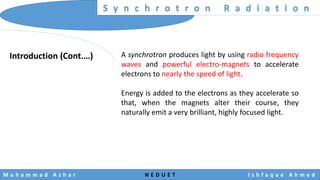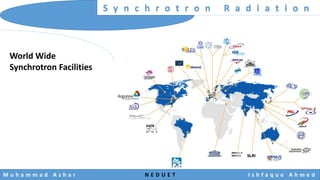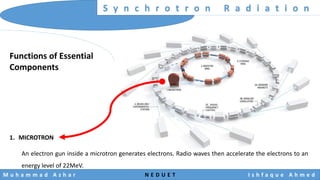Synchrotron radiation
- 2. S y n c h r o t r o n R a d i a t i o n Presented By Course Incharge Muhammad Azhar Ishfaque Ahmed Prof. Dr. Saqib Anjum
- 4. S y n c h r o t r o n R a d i a t i o n Contents • Introduction • Historical Background • World Wide Synchrotron Facilities • Synchrotron Design & its Essential Components • Functions of Essential Components • Detection of Synchrotron Radiation • Properties of Synchrotron Radiation • Advantages of Synchrotron Radiation • Applications M u h a m m a d A z h a r N E D U E T I s h f a q u e A h m e d
- 5. S y n c h r o t r o n R a d i a t i o n Introduction Synchrotron radiation is the electromagnetic radiation emitted when charge particles travel in curved path. In Synchrotron the charge particle moves with constant relativistic speed on a circular arc. The relativistic speed domain make it different from Cyclotron. Ordinary Synchrotron radiation Bending-Magnet Radiation SR M u h a m m a d A z h a r N E D U E T I s h f a q u e A h m e d
- 6. S y n c h r o t r o n R a d i a t i o n Introduction (Cont.…) A synchrotron produces light by using radio frequency waves and powerful electro-magnets to accelerate electrons to nearly the speed of light. Energy is added to the electrons as they accelerate so that, when the magnets alter their course, they naturally emit a very brilliant, highly focused light. M u h a m m a d A z h a r N E D U E T I s h f a q u e A h m e d
- 7. S y n c h r o t r o n R a d i a t i o n Historical Background Synchrotron radiation was named after its discovery in a General Electric synchrotron accelerator built in 1946 and announced in May 1947 by Frank Elder. M u h a m m a d A z h a r N E D U E T I s h f a q u e A h m e d
- 8. S y n c h r o t r o n R a d i a t i o n World Wide Synchrotron Facilities M u h a m m a d A z h a r N E D U E T I s h f a q u e A h m e d
- 9. S y n c h r o t r o n R a d i a t i o n Synchrotron Design & its Essential Components M u h a m m a d A z h a r N E D U E T I s h f a q u e A h m e d
- 10. S y n c h r o t r o n R a d i a t i o n Functions of Essential Components M u h a m m a d A z h a r N E D U E T I s h f a q u e A h m e d 1. MICROTRON An electron gun inside a microtron generates electrons. Radio waves then accelerate the electrons to an energy level of 22MeV.
- 11. S y n c h r o t r o n R a d i a t i o n Functions of Essential Components (Cont.…) M u h a m m a d A z h a r N E D U E T I s h f a q u e A h m e d 2. BOOSTER RING The electrons enter a booster ring where magnets force them to travel in a circular path and radio waves accelerates electrons to 800 MeV.
- 12. S y n c h r o t r o n R a d i a t i o n Functions of Essential Components (Cont.…) M u h a m m a d A z h a r N E D U E T I s h f a q u e A h m e d 3. STORAGE RING The electron beam travels to a storage ring where it races around fo5r hours, reaching 2.5 GeV.
- 13. S y n c h r o t r o n R a d i a t i o n Functions of Essential Components (Cont.…) M u h a m m a d A z h a r N E D U E T I s h f a q u e A h m e d 3A. BENDING MAGNETS Bending magnets adjust the path of the electron beam to keep it inside the storage ring.
- 14. S y n c h r o t r o n R a d i a t i o n Functions of Essential Components (Cont.…) M u h a m m a d A z h a r N E D U E T I s h f a q u e A h m e d 3B. WIGGLERS/UNDULATORS Magnets called wigglers and undulators force to emit a concentrated beam of light.
- 15. S y n c h r o t r o n R a d i a t i o n Functions of Essential Components (Cont.…) M u h a m m a d A z h a r N E D U E T I s h f a q u e A h m e d 3C. RADIO-FREQUENCY CAVITIES Radio-frequency cavities add energy to the circulating electrons to replace the energy that was lost as light.
- 16. S y n c h r o t r o n R a d i a t i o n Functions of Essential Components (Cont.…) M u h a m m a d A z h a r N E D U E T I s h f a q u e A h m e d 4. BEAM LINE/ EXPERIMENTAL STATION The light travel down a beam line, which sends the beam to an experimental station, where optics focus or filter the light to allow scientist to investigate their samples.
- 17. S y n c h r o t r o n R a d i a t i o n Detection of Synchrotron Radiation The synchrotron radiation detected at Experimental Stations Each Experimental Station has 3-Areas M u h a m m a d A z h a r N E D U E T I s h f a q u e A h m e d
- 18. S y n c h r o t r o n R a d i a t i o n Detection of Synchrotron Radiation (Cont...) Optics Hutch=> As X-ray beam pass through the optics hutch it is focused & filtered M u h a m m a d A z h a r N E D U E T I s h f a q u e A h m e d Experimental Hutch=> In this hutch rays strike the mounted sample. This interaction gives the detailed structure Control Cabin=> In control cabin the scientists control the experiment, monitor and analyse the data.
- 19. S y n c h r o t r o n R a d i a t i o n Properties of Synchrotron Radiation • High Intensity • Continuous Spectrum • Excellent Collimation (Brilliance) • Low Emittance • Pulsed-Time Structured • Polarization M u h a m m a d A z h a r N E D U E T I s h f a q u e A h m e d
- 20. S y n c h r o t r o n R a d i a t i o n Advantages of Synchrotron Radiation • An Example. The intensity of synchrotron X-rays is more than a million times higher that of X-rays from a conventional X-ray tube. Experiments that took a month to complete can now be done in only a few minutes. • With synchrotron radiation, molecular structures that once baffled researchers can now be analyzed precisely, and this progress has opened up many new research fields over the last few years. M u h a m m a d A z h a r N E D U E T I s h f a q u e A h m e d
- 21. S y n c h r o t r o n R a d i a t i o n Applications • Life sciences: protein and large-molecule crystallography • LIGA based microfabrication • Drug discovery and research • X-ray lithography • Analyzing chemicals to determine their composition • Observing the reaction of living cells to drugs • Inorganic material crystallography and microanalysis • Fluorescence studies • Semiconductor material analysis and structural studies • Geological material analysis • Medical imaging • Particle therapy to treat some forms of cancer M u h a m m a d A z h a r N E D U E T I s h f a q u e A h m e d
- 22. S y n c h r o t r o n R a d i a t i o n References Albert Hofmann, “The Physics of Synchrotron Radiation” Cambridge University Press, 2004 Herman Winick, “Synchrotron Radiation Sources: A Primer”, World Scientific Publishing, 1995 C. Kunz, “Synchrotron Radiation: Techniques and Applications”, Springer Science & Business Media, 1979 M u h a m m a d A z h a r N E D U E T I s h f a q u e A h m e d
- 23. S y n c h r o t r o n R a d i a t i o n M u h a m m a d A z h a r N E D U E T I s h f a q u e A h m e d























